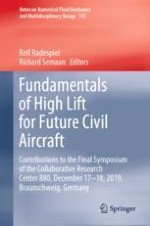This book reports on the latest numerical and experimental findings in the field of high-lift technologies. It covers interdisciplinary research subjects relating to scientific computing, aerodynamics, aeroacoustics, material sciences, aircraft structures, and flight mechanics. The respective chapters are based on papers presented at the Final Symposium of the Collaborative Research Center (CRC) 880, which was held on December 17-18, 2019 in Braunschweig, Germany. The conference and the research presented here were partly supported by the CRC 880 on “Fundamentals of High Lift for Future Civil Aircraft,” funded by the DFG (German Research Foundation). The papers offer timely insights into high-lift technologies for short take-off and landing aircraft, with a special focus on aeroacoustics, efficient high-lift, flight dynamics, and aircraft design.
